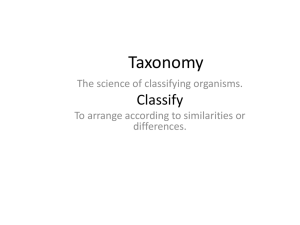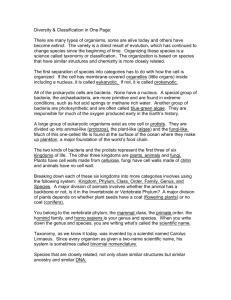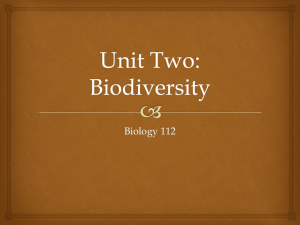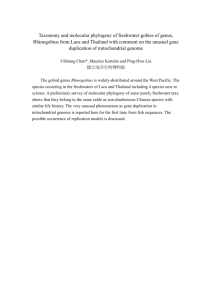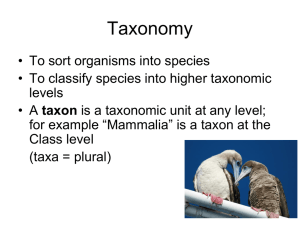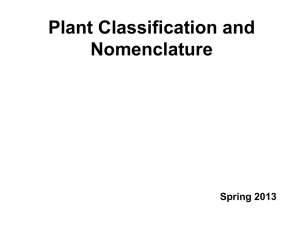Animal Classification, Phylogeny, and Organization
advertisement
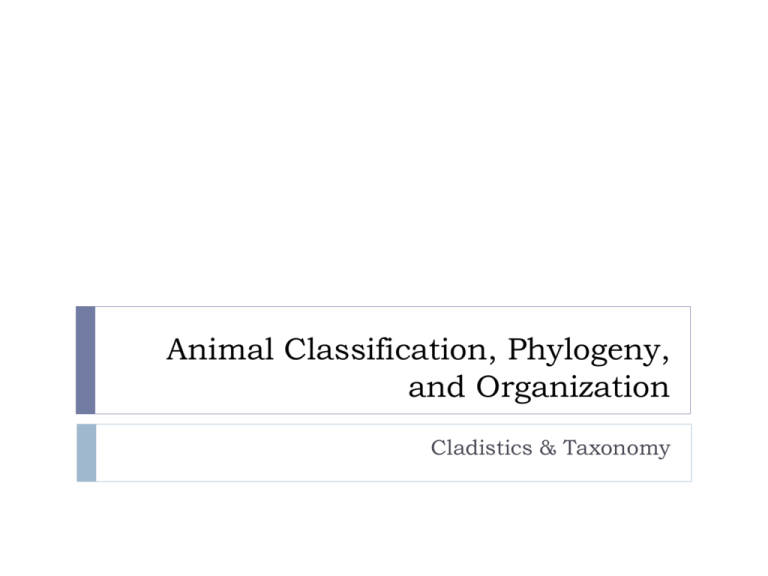
Animal Classification, Phylogeny, and Organization Cladistics & Taxonomy Animal Systematics The goal of animal systematics is to arrange animals into groups that reflect evolutionary relationships. How might you group the animals in the picture? One way to group them is by using phylogenetic systematics, otherwise known as cladistics. Phylogeny refers to the evolutionary ancestry of animals; how they are related to a common ancestor. Cladistics uses the phylogeny of animals to group them according to homologous characters. Character – anything with a genetic basis that can be measured, i.e., anatomy, morphology, or DNA itself. Cladistics Cladistics focuses on monophyletic groups. A monophyletic group refers to a single ancestor species and all of its descendants. Diagrams called cladograms are used to represent the phylogeny of organisms. Characters Symplesiomorphy – a homologous character shared by all members of a monophyletic group. Synapomorphy – a derived character that has arisen after a symplesiomorphy visible in a given outgroup. Groups that share a certain synapomorphy are called a clade. Cats are more similar to dogs than they are to frogs, because they share a more recent common ancestor with dogs Practice Cladogram Construct a Cladogram 7 Gorilla Chimpanzee Tiger Lizard Fish Tail Lost Fur Four Limbs 8 Cladogram Showing Vertebrate Phylogeny Classification Organisms can be classified according to their relatedness to other organisms. The accepted classifications among scientists are called taxonomy. Taxonomy is a hierarchical system. This means that you start very general and get more specific as you proceed down the list. Example - The grocery store is set up the same way! 11 Kingdom Phylum Class Order Family Genus Species Current Biological Classifications Kingdom Phylum Class Order Family Genus Species King Philip Came Over For Grape Soda Example: Human Kingdom Phylum Class Order Family Genus Species Animalia Chordata Mammalia Primates Hominidae Homo sapiens Binomial Nomenclature Bi – 2 Nomen – name The first name is always the GENUS The second name is always the SPECIES Thus, our binomial nomenclature is homo sapiens. The binomial nomenclature of a house cat is felis catus. The binomial nomenclature of a killer whale is orcinus orca. Example: Dog Kingdom Phylum Class Order Family Genus Species Subspecies Animalia Chordata Mammalia Carnivora Canidae Canis lupus familiaris The 5 Kingdoms Kingdom: Monera – true bacteria and cyanobacteria Protista – eukaryotic, unicellular or colonial, usually motile, microscopic in size (amoeba, paramecium, etc.) Plantae – eukaryotic, multicellular, photosynthetic, have cell walls, nonmotile Fungi – eukaryotic, multicellular, decomposer, have cell walls, usually nonmotile Animalia – eukaryotic, multicellular, heterotrophic, no cell walls, motile, specialized tissues

